| Latest | Greatest | Lobby | Journals | Search | Options | Help | Login |
|
|
|
This topic is archived. |
| Home » Discuss » Topic Forums » Sports |
|
| Jack Rabbit
|
Fri Feb-29-08 05:28 PM Original message |
| The Jack Rabbit Chess Report (February 29): Anand leads Linares |
|
Anand leads in Linares
 World champion Vishy Anand of India leads the Morelia-Linares International Tournament with 6 points after today�s ninth round. Seventeen-year-old Norwegian GM Magnus Carlsen is second with 5� points and Armenia�s Levon Aronian is third with 5. The tournament left Morelia, Minoach�n (Mexico) after last Saturday�s seventh round and yesterday resumed in the event�s original home, the Andalucian mining town of Linares in Spain. Anand drew his game today against Aronian, who defeated the world champion in the second round in Morelia. Yesterday, Anand defeated the Latvian-Spanish grandmaster, Alexey Shirov, for the second time in the event. In other action today, Magnus defeated Shirov in an 80-move marathon, former FIDE world champion Veselin Topalov of Bulgaria and 20-year-old Azerbaijani grandmaster Teimour Radjabov drew and Vassily Ivanchuk of Ukraine scored a victory with Black over Hungary�s Peter Leko. The tenth round takes place tomorrow. Live coverage is available on the event�s official website. Morozevich will pass on Grand Prix 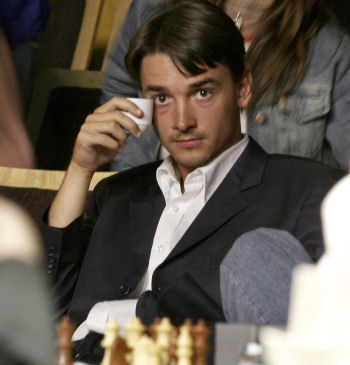 Alexander Morozevich Alexander Morozevich of Russia, the fourth-ranked grandmaster in the world and one of the most colorful, announced during the week that he will not play in the FIDE Grand Prix, the cycle designed to choose candidates for the next world championship cycle. Morozevich, speaking in an interview with the Russian periodical Sport Express. said that it is unfair for FIDE to require that player sign a contract for four tournaments �without having any definite information about where or when they will be held.� However, Morozevich said he will participate in the 2009 World Cup, by which he could also qualify for the world championship cycle. |
| Printer Friendly | Permalink | | Top |
| Jack Rabbit
|
Fri Feb-29-08 05:32 PM Response to Original message |
| 1. Games from Morelia-Linares |
|
Diagrams on the Jack Rabbit Chess Report are made with Chess M�rida, a true type font that can be downlaoded free here. !""""""""# $tMvWlVmT% $OoOoOoOo% $ + + + +% $+ + + + % $ + + + +% $+ + + + % $pPpPpPpP% $RnBqKbNr% /(((((((() WHITE White to move This position is a theoretical draw |
| Printer Friendly | Permalink | | Top |
| Jack Rabbit
|
Fri Feb-29-08 05:34 PM Response to Reply #1 |
| 3. Topalov - Carlsen, Round 5, Morelia |
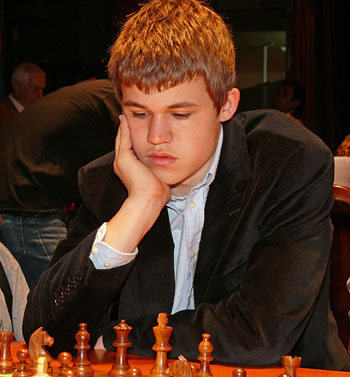 Magnus Carlsen Veselin Topalov - Magnus Carlsen Morelia-Linares International Tournament, Round 5 Morelia, Michoac�n (Mexico), 20 February 2008 Moorish Game: Horseman's Defense (Alekhine's Defense) 1.e4 Nf6 2.e5 Nd5 3.d4 d6 4.Nf3 dxe5
5.Nxe5 c6 6.Bd3
6...Nd7 7.Nxd7
7...Bxd7 8.0-0 g6 9.Nd2
9...Bg7 10.Nf3 0-0 11.Re1!?
11...Bg4
12.c3
!""""""""# $t+ W Tl+% $Oo+ OoVo% $ +o+ +o+% $+ +m+ + % $ + P +v+% $+ Pb+n+ % $pP + PpP% $R BqR K % /(((((((() WHITE: Veselin Topalov Position after 12.c2c3 12...c5!?
13.Be4?
13...cxd4 14.cxd4
14...e6 15.Qb3
15...Bxf3 16.Bxf3 Bxd4!
17.Bxd5 Qxd5 18.Qxd5 exd5 19.Rd1 Bg7 20.Kf1
!""""""""# $t+ + Tl+% $Oo+ +oVo% $ + + +o+% $+ +o+ + % $ + + + +% $+ + + + % $pP + PpP% $R Br+k+ % /(((((((() WHITE: Veselin Topalov Position after 20.Kg1f1 20...Rfd8 21.Bg5
21...Rd7 22.Rd2 h6 23.Be3 d4 24.Rd3 Rc8 25.Bd2
25...Rc2 26.Rb1 Re7 27.a4 f5 28.b3 Rec7 29.Be1
29...Kf7 30.Rd2 Rc1 31.Rxc1 Rxc1 32.Ke2
32...Rb1!
33.Rd3 Ke6 34.h4 Kd5 35.Bd2 Ke4 36.Rg3
36...f4 37.Rd3
37...Be5 38.f3+ Kd5 39.Be1 Bd6
40.Bd2 g5 41.hxg5 hxg5 42.Be1 !""""""""# $ + + + +% $Oo+ + + % $ + V + +% $+ +l+ O % $p+ O O +% $+p+r+p+ % $ + +k+p+% $+t+ B + % /(((((((() WHITE: Veselin Topalov Position after 42.Bd2e1 42...g4!
43.fxg4
43...Ke4 0-1
|
| Printer Friendly | Permalink | | Top |
| Jack Rabbit
|
Fri Feb-29-08 05:36 PM Response to Reply #1 |
| 4. Aronian - Leko, Round 6, Morelia |
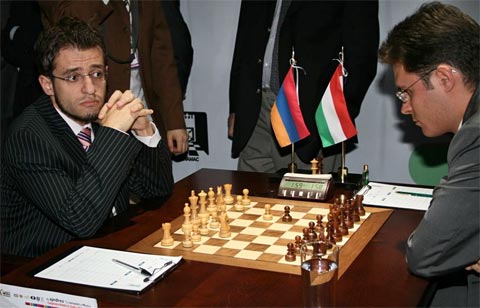 Levon Aronian and Peter Leko Levon Aronian - Peter Leko Morelia-Linares International Tournament, Round 6 Morelia, Michoac�n (Mexico), 22 February 2008 English Symmetrical Game: Four Knights' Opening 1.c4 c5 2.Nf3 Nf6 3.Nc3 Nc6 4.d4 cxd4 5.Nxd4 e6 6.g3 Qb6 7.Ndb5
7...Ne5 8.Bf4
8...Nfg4 9.Qa4!
!""""""""# $t+b+lV T% $Oo+o+oOo% $ W +o+ +% $+n+ M + % $q+p+ Bm+% $+ N + P % $pP +pP P% $R + Kb+r% /(((((((() WHITE: Levon Aronian Position after 9.Qd1a4 9...g5!!
10.Bxe5 Nxe5
11.0-0-0
11...a6 12.e3 Rb8 13.Nd4 Qc7 14.Be2
14...Be7 15.Kb1 Nc6
16.Rc1 Qe5 17.Rhd1 h5
18.Ka1 g4
19.Bf1 f5
20.Bg2 !""""""""# $ Tv+k+ T% $+o+o+ + % $o+m+o+ +% $+ + Wo+o% $q+pN +o+% $+ N P P % $pP + PbP% $K Rr+ + % /(((((((() WHITE: Levon Aronian Position after 20.Bf1g2 20...Kf7
21.h3 Bf6 22.Qc2
22...Ne7 23.Nce2 b5
24.cxb5
24...axb5 25.Nf4 d5 26.Qc5
26...Rb7 27.Qb4 Bd7
28.Nd3 Qb8 29.Nc5 Qd6
30.Qa5 Rc7 31.Nxd7 Rxd7 32.hxg4
32...hxg4 33.Bf1 b4 34.Nb5 Qe5
35.Qxb4
35...Ra8 36.Rd2 Qb8 37.Kb1 Be5 38.Rdc2 Rda7 39.a3 Ra4
40.Qb3 Qb6 41.Rc5
41...R4a5 42.Be2 Rb8 43.Qb4
43...Kf6 44.R1c2 Rh8 45.e4 fxe4 46.Bxg4 Rha8
47.Rc1
47...Ra4 48.Qd2 Rxa3 49.Nxa3 Rxa3 50.Rc6 �-�
|
| Printer Friendly | Permalink | | Top |
| Jack Rabbit
|
Fri Feb-29-08 05:38 PM Response to Reply #1 |
| 5. Shirov - Radjobov, Round 7, Morelia |
 Alexey Shirov Alexey Shirov - Teimour Radjabov Moelia-Linares International Tournament, Round 7 Morelia, Michoac�n (Mexico), 23 February 2008 West India Game: King's Indian Defense 1.d4 Nf6 2.c4 g6 3.Nc3 Bg7 4.e4 d6 5.Be2 0-0 6.Nf3 e5 7.0-0 Nc6
8.d5 Ne7 9.Ne1 Nd7 10.Be3
10...f5 11.f3 f4 12.Bf2 g5 13.Nd3
13...h5!?
14.c5
14...Nf6 15.Rc1 g4?
16.Nb5 Ne8
!""""""""# $t+vWmTl+% $OoO M V % $ + O + +% $+nPpO +o% $ + +pOo+% $+ +n+p+ % $pP + +pP% $+ Rq+rK % /(((((((() WHITE: Alexey Shirov Position after 16...Nf6e8 17.fxg4
17...a6 18.Nc3 hxg4 19.Bxg4 Nf6
20.Bxc8 Rxc8 !""""""""# $ +tW Tl+% $+oO M V % $o+ O M +% $+ PpO + % $ + +pO +% $+ Nn+ + % $pP + BpP% $+ Rq+rK % /(((((((() WHITE: Alexey Shirov Position after 20...Ra8c8:B 21.g3
21...Qe8 22.Kh1 Qg6 23.Qe2 f3 24.Qxf3 Nfxd5 25.Nxd5 Nxd5
26.Qe2 Nf6 27.Rce1
27...Qf7 28.g4 Qg6
29.h3 Rf7 30.Kg2 Nd7
31.Bg1 Qe6 32.b3 Rxf1
33.Rxf1 d5
!""""""""# $ +t+ +l+% $+oOm+ V % $o+ +w+ +% $+ PoO + % $ + +p+p+% $+p+n+ +p% $p+ +q+k+% $+ + +rB % /(((((((() WHITE: Alexey Shirov Position after 33...d6d5 34.g5!
34...a5
35.h4 Qc6 36.Re1 Rf8 37.exd5 Qxd5+ 38.Qe4 c6
39.Bh2 Qe6 40.Bg3
40...Rf5 41.a3
41...Rf7 42.b4
42...Qa2+
43.Re2 Qxa3 44.g6! 1-0
|
| Printer Friendly | Permalink | | Top |
| Jack Rabbit
|
Fri Feb-29-08 05:33 PM Response to Original message |
| 2. Games from other recent events |
|
Diagrams on the Jack Rabbit Chess Report are made with Chess M�rida, a true type font that can be downlaoded free here. !""""""""# $tMvWlVmT% $OoOoOoOo% $ + + + +% $+ + + + % $ + + + +% $+ + + + % $pPpPpPpP% $RnBqKbNr% /(((((((() WHITE White to move This position is a theoretical draw |
| Printer Friendly | Permalink | | Top |
| Jack Rabbit
|
Fri Feb-29-08 05:39 PM Response to Reply #2 |
| 6. Nepomniachtchi - Dreev, Areoflot Open, Moscow |
|
Edited on Fri Feb-29-08 06:15 PM by Jack Rabbit
Seventeen-year-old rising star Ian Napomniachtchi of Russia is the champion of the 2008 Areoflot Open
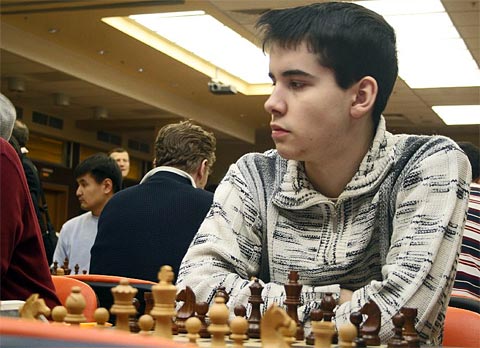 Ian Nepomniachtchi Ian Nepomniachtchi - Alexey Dreev Aeroflot Open. Round 3 Moscow (3), 16 February 2008 Open Sicilian Game: Italian Opening (Sozin Opening) 1.e4 c5 2.Nf3 d6 3.d4 cxd4 4.Nxd4 Nf6 5.Nc3 Nc6 6.Bc4 Bd7
7.Bg5
7...Qa5 8.Bxf6 gxf6 9.Nb3 Qg5 10.g3
10...f5 11.e5 Be6!?
12.Bxe6
12...fxe6 13.Nd4
13...Nxd4
14.Qxd4
14...Bg7 15.Qa4+
15...Kf7 16.exd6!?
16...Bxc3+ 17.bxc3 exd6 18.0-0
18...Rhe8 19.Rad1 d5?
20.c4 dxc4
21.Rd7+ Re7 22.Rfd1 Rae8
23.Qxa7 Qg4 !""""""""# $ + +t+ +% $Qo+rTl+o% $ + +o+ +% $+ + +o+ % $ +o+ +w+% $+ + + P % $p+p+ P P% $+ +r+ K % /(((((((() WHITE: Ian Nepomniachtchi Position after 23...Qg5g4 24.Qe3
24...Rxd7 25.Rxd7+ Re7 26.Rd4
26...Qg7 27.a4
27...Rc7 28.Qf4
28...Kg6 29.c3 Qe7 !""""""""# $ + + + +% $+oT W +o% $ + +o+l+% $+ + +o+ % $p+oR Q +% $+ + + P % $ + + P P% $+ + + K % /(((((((() WHITE: Ian Nepomniachtchi Position after 29...Qg7e7 30.Rxc4!
30...e5
31.Rxc7 Qxc7 32.Qd2 Qc6
33.a5 Qc5 34.c4 e4
35.Qd8 Qe5
36.Qb6+ Kh5 37.Qxb7 Kg6
38.a6 Qa1+ 39.Kg2 Qa3 40.Qb6+ Kf7 41.h4 1-0
|
| Printer Friendly | Permalink | | Top |
| Jack Rabbit
|
Fri Feb-29-08 05:42 PM Response to Reply #2 |
| 7. Gharamian - Gashimov, Open, Cappelle la Grande |
|
Vugar Gashimov of Azerbaijan was one of eight players to tie for the lead in Cappelle la Grand. He was awarded the tournament championship based on his tie-break score.
 Vugar Gashimov To view this game with a PGN viewer:
Tigran Gharamian - Vugar Gashimov 24th Open, Round 9 Cappelle la Grande, 23 February 2008 Closed Sicilian Game: Saragossa Opening (Alapin Variation) 1.e4 c5 2.Nf3 g6 3.c3
3...Bg7
4.d4 cxd4 5.cxd4 d5 6.e5 Nh6
7.h3!?
7...0-0
8.Be2
8...Nc6 9.0-0
9...Bf5 10.Nc3 Be4 11.Ng5
11...Qb6
12.e6?!
12...Nxd4 13.Ngxe4 dxe4 14.Bxh6 Bxh6 15.exf7+ Rxf7
16.Bc4
16...e6 17.Ne2?
!""""""""# $t+ + +l+% $Oo+ +t+o% $ W +o+oV% $+ + + + % $ +bMo+ +% $+ + + +p% $pP +nPp+% $R +q+rK % /(((((((() WHITE: Tigran Gharamian Position after 17.Nc3e2 17...Bg7!
18.Nxd4 Bxd4 19.Qe2
19...Qc6
20.Rad1 Rd8 21.b3 Kg7 22.Qg4
22...Rf5
23.a4 a6 24.Kh1 e5 25.f4
25...h5 26.Qh4 Qf6 27.Qxf6+ Kxf6 28.g3
28...exf4 29.gxf4 Rc5 30.Rd2
30...b5 31.axb5 axb5 32.Be2 Kf5 33.Kg2
!""""""""# $ + T + +% $+ + + + % $ + + +o+% $+oT +l+o% $ + VoP +% $+p+ + +p% $ + Rb+k+% $+ + +r+ % /(((((((() WHITE: Tigran Gharamian Position after 33.Kh1g2 33...Bf6!
34.Rxd8 Bxd8 35.b4!
35...Rc7
36.Bxb5 Bh4 37.Ba4
37...Rc3 38.Rb1 Rg3+ 39.Kh2
39...Ra3 40.Bd7+ Kxf4 41.b5
41...Ra2+ 42.Kh1 e3 43.Be6 Rd2
44.Bc4 e2 45.Bxe2
45...Rxe2 46.b6 Re8 47.b7 Rb8 48.Rb4+ Kg3 49.Rb3+ Kf2
50.Rb2+ Ke3 51.Kg2 g5 0-1
|
| Printer Friendly | Permalink | | Top |
| Jack Rabbit
|
Fri Feb-29-08 05:44 PM Response to Reply #2 |
| 8. Kotronias - Dervishi, Open, Capelle la Grande |
|
Greek grandmaster Vasilios Kotranias was also one of those tied for first in Cappelle la Grande.
 Vasilios Kotronias To view this game with a PGN viewer:
Vasilios Kotronias - Erald Dervishi 24th Open, Round 8 Cappelle la Grande, 22 February 2008 Sardinian Epine Dorsal: Rat Defense (Philidor's Defense) 1.e4 e5 2.Nf3 d6 3.d4 Nd7
4.Bc4 h6!?
5.0-0
5...Ngf6!?
6.Nc3
6...c6 7.a4
7...Qc7
8.a5 g6
9.h3
9...Bg7 10.dxe5
10...Nxe5 11.Ba2 0-0 12.Nh4
12...Kh7 13.f4 Ned7 14.Be3 Qd8 15.Qf3 Nxe4 16.Nxe4 d5
17.Bf2
17...dxe4 18.Qxe4 f5 19.Qd3 Bxb2 20.Rad1 Qf6
21.Rfe1 Qg7
22.Qg3 g5?!
23.fxg5 hxg5 24.Nf3 Bf6
!""""""""# $t+v+ T +% $Oo+m+ Wl% $ +o+ V +% $P + +oO % $ + + + +% $+ + +nQp% $b+p+ Bp+% $+ +rR K % /(((((((() WHITE: Vasilios Kotronias Position after 24...Bb2f6 25.Be6!
25...Ne5
26.Bxc8 Nxf3+ 27.Qxf3 Raxc8 28.Qxf5+
28...Qg6 29.Rd7+!
29...Bg7 30.Qxg6+
30...Kxg6 31.Rxb7 Rf7 32.a6 Rcc7
33.Reb1 c5!
34.Bg3
34...Bd4+ 35.Kh2 Rce7 36.Bb8 c4
37.R1b4 Re1 38.Rxf7 Kxf7 39.Rxc4
39...Bg1+ 40.Kg3 Kg6
41.Kg4 Re6 42.Ra4
42...Re2 43.g3 Rxc2 44.h4 gxh4 45.gxh4 Be3 46.h5+ Kf7?
!""""""""# $ B + + +% $O + +l+ % $p+ + + +% $+ + + +p% $r+ + +k+% $+ + V + % $ +t+ + +% $+ + + + % /(((((((() WHITE: Vasilios Kotronias Position after 46...Kg6f7 47.Rb4!
47...Ra2
48.Bxa7 Bxa7 49.Rb7+ Kf6 50.Rxa7 Ra4+
51.Kf3 Kg5 52.Ra8 Rf4+
53.Ke3 Rf7 54.Rb8 Ra7 55.Rb5+ 1-0 |
| Printer Friendly | Permalink | | Top |
| Jack Rabbit
|
Fri Feb-29-08 05:47 PM Response to Reply #2 |
| 9. Lombart - Hoolt, Open, Cappelle la Grande |
|
German WFM Sarah Hoolt, 19, scored 5 out of 9 at Cappelle la Grande and recieved norms for both a WIM and WGM title.
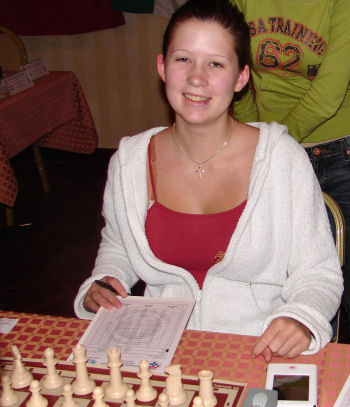 Sarah Hoolt To view this game with a PGN viewer:
Philippe Lombart - Sarah Hoolt 24th Open, Round 1 Cappelle la Grande, 16 February 2008 West India Game: King's Indian Defense 1.d4 Nf6 2.c4 g6 3.Nc3 Bg7 4.g3 0-0 5.Bg2 d6 6.Nf3 Nbd7 7.h3 e5 8.Be3
8...a6!?
9.0-0 exd4 10.Bxd4 Re8 11.Qc2 Qe7 12.Rfe1
12...Ne5 13.Bxe5
13...dxe5 14.e4 c6!
15.Rad1 Nd7
16.a3 b5 17.cxb5
17...axb5 18.Na2 Bb7 19.Nb4 Rac8
20.Qd2
20...Nb6 21.Qd6?!
21...Qxd6 22.Rxd6 Bf8
23.Rdd1 Nc4 24.Rd7
24...Ba8
25.Ng5?
!""""""""# $v+t+tVl+% $+ +r+o+o% $ +o+ +o+% $+o+ O N % $ Nm+p+ +% $P + + Pp% $ P + Pb+% $+ + R K % /(((((((() WHITE: Philippe Lombart Position after 25.Nf3g5 25...Be7!
26.h4 Nxb2
27.Bh3 Rcd8 28.Rc1 Nc4
29.Rc7
29...h6 30.Nf3 c5 31.Nd5 Bxd5 32.exd5 e4
33.Ne1
33...Bd6 34.Ra7 !""""""""# $ + Tt+l+% $R + +o+ % $ + V +oO% $+oOp+ + % $ +m+o+ P% $P + + Pb% $ + + P +% $+ R N K % /(((((((() WHITE: Philippe Lombart Position after 34.Rc7a7 34...Ra8!
35.Rd7 Bf8 36.Rb7 Nxa3 37.Nc2 Nxc2 38.Rxc2 b4 39.Bf1
39...Reb8 40.Rxb8 Rxb8 41.Rb2
41...Bg7
42.Rb3 Bd4 43.Kg2
43...Ra8 44.Be2 Kf8 45.g4 Ke7 46.f3
46...Ra2 47.Kf1 Ra1+ 48.Kg2 Rg1+ 49.Kh2 Re1 50.Bc4 e3 0-1
|
| Printer Friendly | Permalink | | Top |
| DU
AdBot (1000+ posts) |
Fri Apr 26th 2024, 06:07 PM Response to Original message |
| Advertisements [?] |
| Top |
| Home » Discuss » Topic Forums » Sports |
|
Powered by DCForum+ Version 1.1 Copyright 1997-2002 DCScripts.com
Software has been extensively modified by the DU administrators
Important Notices: By participating on this discussion board, visitors agree to abide by the rules outlined on our Rules page. Messages posted on the Democratic Underground Discussion Forums are the opinions of the individuals who post them, and do not necessarily represent the opinions of Democratic Underground, LLC.
Home | Discussion Forums | Journals | Store | Donate
About DU | Contact Us | Privacy Policy
Got a message for Democratic Underground? Click here to send us a message.
© 2001 - 2011 Democratic Underground, LLC